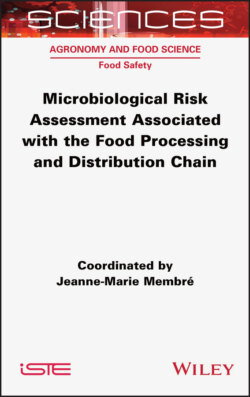Читать книгу Microbiological Risk Assessment Associated with the Food Processing and Distribution Chain - Jeanne-Marie Membre - Страница 4
List of Illustrations
Оглавление1 IntroductionFigure I.1. Factors influencing the evolution of food safety. From the FAO and W...Figure I.2. The three components of risk analysis: risk assessment, risk managem...Figure I.3. Microbiological risk assessment. Adapted from the FAO and WHO (2020)
2 Chapter 1Figure.1.1. Structuring of information essential to hazard identification. Creat...
3 Chapter 2Figure 2.1. Schematic representation of the three internationally recommended cu...Figure 2.2. Conventional culture-based and nucleic acid-based methods for the de...Figure 2.3. Quantitative real-time PCR curves. (A) Real-time PCR kinetics, with ...Figure 2.4. Real-time PCR detection systems. (A) Fluorescent probe-based qPCR. T...Figure 2.5. Main steps of digital droplet PCR (ddPCR). Step 1: preparation of th...Figure 2.6. Main steps of whole genome sequencing (WGS). Adapted from Next Gener...Figure 2.7. Summary of the potential use of NGS by the food industry according t...Figure 2.8. Overview of common enzyme-linked immunosorbent assay (ELISA) formats...Figure 2.9. Matrix-assisted laser desorption/ionization time-of-flight (MALDI-TO...
4 Chapter 3Figure 3.1. In the farm-to-fork food pathway, prevalence and concentrations are ...Figure 3.2. A schematic representation of the food pathway for a QMRA of E. coli...Figure 3.3. Food pathway for Danish meatballs. Meatballs are produced from mince...Figure 3.4. The result of the exposure assessment, showing the frequencies of th...
5 Chapter 4Figure 4.1. Simplified schematic representation of bacterial virulence events in...Figure 4.2. Mechanisms of action of toxins produced in vivo by Campylobacter jej...Figure 4.3. Schematic attachment and effacement mechanisms of E. coli EHEC. Infe...Figure 4.4. “Zipper” versus “trigger” mechanisms of bacterial internalization by...Figure 4.5. Theoretical Campylobacter jejuni mechanisms of intestinal infection....Figure 4.6. Evolution of in vitro cell models to study host–foodborne pathogen i...
6 Chapter 5Figure 5.1. Examples of exponential distribution. For a color version of this fi...Figure 5.2. Examples of beta distribution. Top: probability density function (pd...Figure 5.3. Examples of beta-Poisson dose–response models. For a color version o...Figure 5.4. Examples of beta-Poisson dose–response models. The parameters α and ...Figure 5.5. Dose–response models (probability of severe listeriosis cases condit...Figure 5.6. Best-fitting curve from the beta-Poisson model and the 95% and 99% c...Figure 5.7. Beta-Poisson bootstrap estimates (10,000 iterations – data in Table ...Figure 5.8. Incidence rates of hemolytic uremic syndrome (HUS) attributable to e...Figure 5.9. Visualization of the Bayesian statistical model for estimating the α...Figure 5.10. Dose–response relationship estimated based on data collected from n...
7 Chapter 6Figure 6.1. Relation between the 11 inputs (X) and the outputs (Y) of the Risk R...Figure 6.2. Different measures of riskFigure 6.3. Illustration of DALYs with the case of a person who falls sick and d...Figure 6.4. Risk management metrics in the food production chain. ALOP: appropri...Figure 6.5. (A) Illustration of the two-dimensional Monte-Carlo simulation with ...
8 ConclusionFigure C.1. Breakdown of the 1,037 published articles on microbiological risk as...Figure C.2. Microbiological risks repositioned in a more general risk assessment...Figure C.3. Example of categorization of microbiological risks based on their pr...Figure C.4. Method for simultaneous risk ranking of microbiological and chemical...
9 AppendicesFigure A.1. Diagram of cooked ham production, adapted from Zwietering et al. (20...Figure A.2. Combination of thermal processing and pH guaranteeing a 6 log degree...
